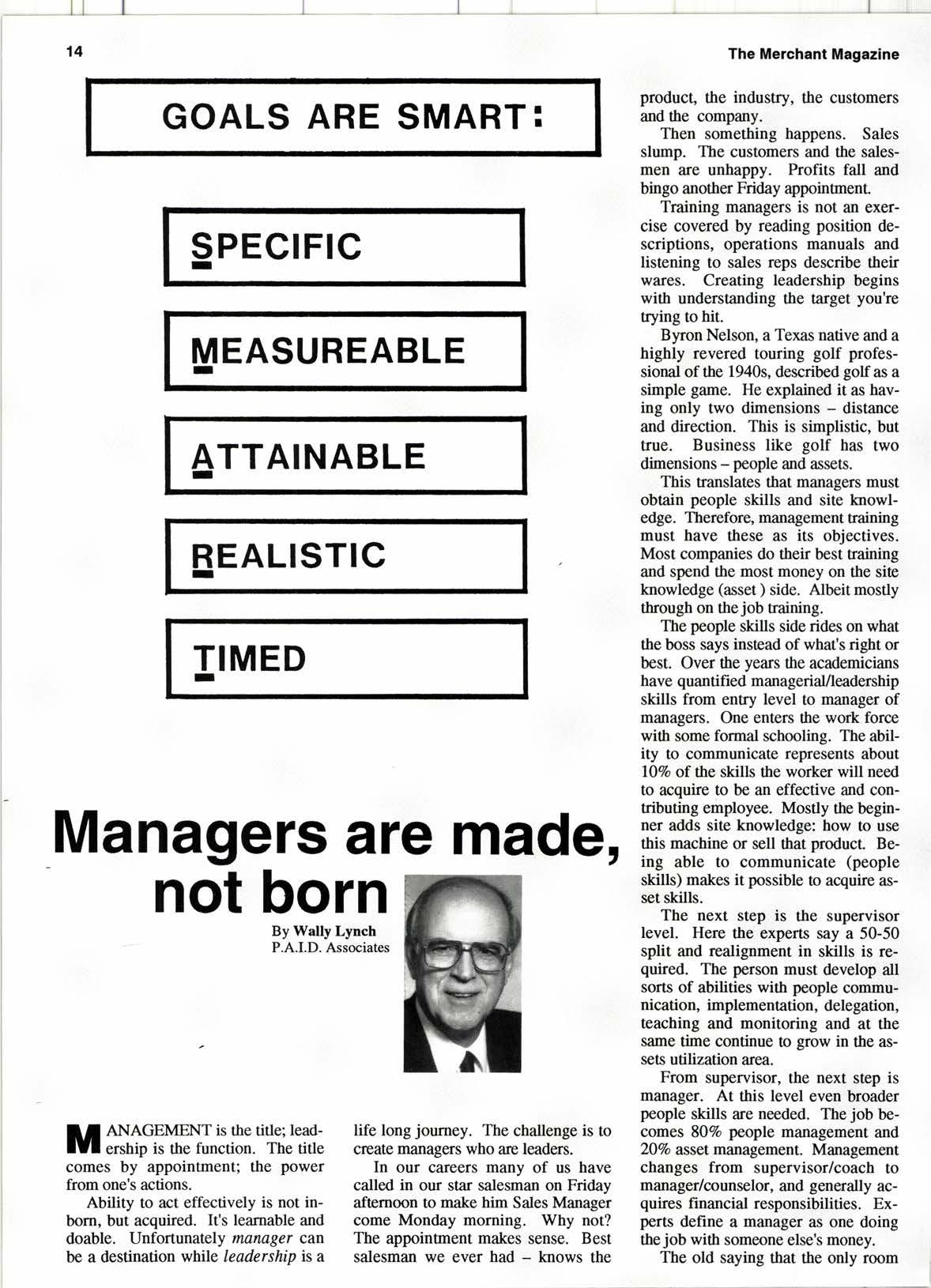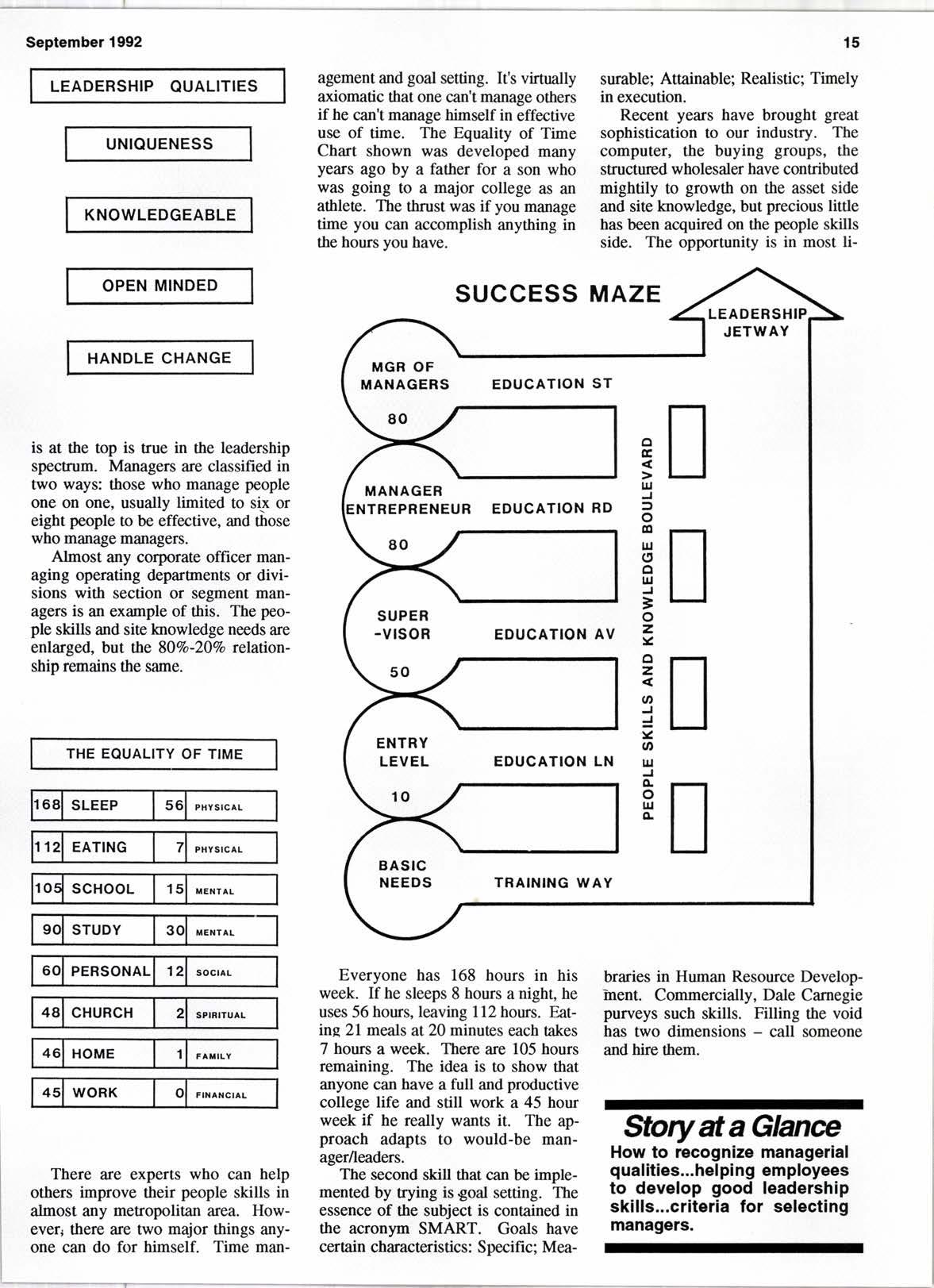
3 minute read
I MEASUREABLE I ATTAINABLE I REALISTIC I TIMED I Managers are made, not born
By \ilally Lyneh P.A.I.D. Associates
ANAGEMENT is the title; leadership is the function. The title comes by appointment; the power from one's actions.
Ability to act effectively is not in' born, but acquired. It's learnable and doable. Unfortunately twrutger can be a destination while leadership is a life long journey. The challenge is to create managers who are leaders.
In our careers many of us have called in our star salesman on Friday afternoon to make him Sales Manager come Monday morning. Why not?
The appoinonent makes sense. Best salesman we ever had * knows the
Training managers is not an exercise covered by reading position descriptions, operations manuals and listening to sales reps describe their wares. Creating leadership begins with understanding the target you're rying ro hir.
Byron Nelson, a Texas native and a highly revered touring golf professional ofthe 1940s, described golfas a simple game. He explained it as having only two dimensions * distance and direction. Tbis is simplistic, but true. Business like golf has two dimensions - people and assets.
This translates that managers must obtain people skills and site lnowledge. Thereforg rurnagement training must have Oese as its objectives. Most companies do their best trainlng and spend the most money on the siE tnowledge (asset ) side. Albeit mostly through on thejob training.
The people skills side rides on what the boss says instead of what s right or best. Over tbe years the academicians have quantified manageriaVleadership skills from entry level to manager of managers. One enters the work force with some formal schooling. The ability to communicate represents about l07o of. the skills the worker will need to rcquire to be an effective and contributing employee. Mostly the beginner adds site knowledge: how to use this machine or sell that product Being able to communicate (people ikills) makes it possible o acquire asset skills.
The next step is the supervisor level. Here the experts say a 50-50 split and realignment in skills is required. The person must develop all sorts of abilities with people communication, implementation, delegation, teaching and monitoring and at the same time continue to grow in the assets utilization area.
From supervisor, the next step is nanager. At this level even broader peopte skills are needed. Thejob becomes 807o people management and 207o asset management. Management changes from supervisor/coach to manager/oounselor, and generally acquires financial responsibilities. Experts define a manager as one doing the job with someone else's money.
The old saying that the only room is at the top is true in the leadership spectrum. Managers are classified in two ways: those who manage people one on one, usually limited to six or eight people to be effective, and tiose who manage managers. agement and goal setting. It's virtually axiomatic tbat one can't manage otbers if he can't manage himself in effective use of time. The Equality of Time Chart shown was developed many years ago by a father for a son who was going to a major college as an athlete. The tbrust was if you manage time you can accomplish anything in the hours you have. surable; Attainable; Realistic; Timely in execution.
Almost any corpofate officer managing operating deparurents or divi sions with section or segment managers is an example of this. The people skills and site lnowledge needs are enlarged, but the SOVT-Z$% relationship remains tle same.

Recent years have brought great sophistication to our industry. The computer, the buying groups, the structurcd wholesaler have conributed mightily to growth on the asset side and site knowledge, but precious little has been acquired on the people skills side. The opportunity is in most li-
Success Maze
There are experts who can help otbers improve their people skills in alnost any meEopolitan area. Howevert there are two major things anyone can do for himself. Time man-
Everyone has 168 hours in his week. If he sleeps 8 hours a night, he uses 56hours, leaving ll2hours. Eatins 21 meals at 20 minutes each takes 7 houn a week. There are 105 hours remaining. The idea is to show that anyone can have a full and productive college life and still work a 45 hour week if he really wants it. The approach adapts to would-be managerAeaders.
The second skill that can be implemented by trying is goal setting. The essence of the subject is con0ained in the acronym SMART. Goals have certain characteristics: Specific; Mea- braries in Human Resource Develophrent. Commercially, Dale Carnegie purv€ys such skills. Filling the void has two dimensions - call someone and hire them.










